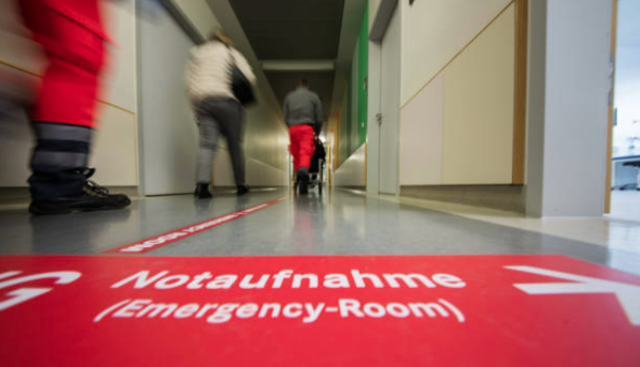
Time is of the essence in the emergency department, where a prompt diagnosis can litreally mean the difference between life and death.
In this environment, access to point-of-care ultrasound is essential, providing vital information to help clinicians rapidly determine the most appropriate course of action for emergency patients. Dr. Martin Langer, clinical lead for emergency medicine at the Evangelisches Krankenhaus Unna, describes the importance of ultrasound in his department.
The Evangelisches Krankenhaus Unna is a 324-bed, district hospital in Germany that includes a certified stroke unit and the local trauma centre for the region, seeing more than 20,000 patients a year in its emergency department. Point-of-care ultrasound has become an indispensable tool in the emergency medicine department, particularly for the acute care of severely injured patients admitted to the resuscitation room.
Improving the quality of care
Dr. Martin Langer, lead consultant for the ED, has a strong background in emergency medicine, intensive care and palliative care, as well as expertise in using ultrasound in these settings. He explained:
“We’ve been using point-of-care ultrasound in the department for 15 years now, and could not do without it. We routinely perform eFAST ultrasound (extended focused assessment with sonography for trauma) examinations on severely injured patients within the first minutes after their admission. This allows us to quickly check the condition of the heart and the integrity of the lungs, and see if there is any free-flowing fluid in the chest or the abdomen. We can determine instantly whether the patient has a potentially life-threatening condition, such as a collapsed lung or heavy bleeding in the abdomen, that requires immediate action before any further diagnostic tests may be carried out. Generally, the faster we act, the more we can minimise the damage within a patient; the efficiency, quality of care and patient outcomes are much better this way, and often the length of time the patient needs to stay in hospital is significantly reduced. Point-of-care ultrasound gives us immediate information, which is a huge benefit.”
Same information from a non-invasive technique
The ready availability of point-of-care ultrasound in the department means fewer X-rays and a reduction in invasive procedures for patients.
“In the past, we used X-ray to look at the lungs, or inserted a cannula to flush fluid through a patient’s abdominal cavity to check for blood. Now, we nearly always perform a non-invasive ultrasound examination instead, which gives us the same information but is much better for the patient. If emergency surgery is required, ultrasound imageing can be complemented by a CT scan, if still possible and necessary, to provide the surgeon with even more information; operating "blind", without any diagnostic information, is always the last resort.”
Point-of-care ultrasound is also used to good effect helping fast clinical decision making on patients with a less severe diagnosis who require less urgent treatment:
“Sometimes patients come to us with unexplained aches and pains that require further investigation. For example, a patient might be admitted from a nursing home with unexplained stomach pains, and ultrasound imageing shows that it is due to a full bladder, easily solved by inserting a catheter. We can also quickly and easily look, for example, for indications of appendicitis, gallstones or kidney problems.”
Passionate about ultrasound
The entire hospital at Unna adopted point-of-care ultrasound relatively early in its development, and continues to advocate its routine use, running training courses at an advanced level that few other clinics offer to external medical personnel. Dr. Langer explained:
“Anaesthetists in Germany as a whole were relatively late in recognising the potential of ultrasound – internal medicine specialists and surgeons adopted the technique many years earlier – but Unna got involved quite early on. I have worked here for two decades and have been continually developing my ultrasound skills, working closely with my colleague Dr. Wolf Armbruster – head of anaesthesia, intensive medicine and pain therapy at the hospital and an ultrasound course instructor, as well as author of one of the most popular ultrasound training books in Germany – to promote advanced training in the use of ultrasound in all our hospital departments. We are passionate about ultrasound and very keen to promote its use.”
A comprehensive device connected to the HIS
The hospital has had a long association with FUJIFILM Sonosite, with the state-of-the-art Sonosite X-Porte system the latest addition. He added:
“The X-Porte is such a comprehensive device, with excellent image quality and a large display screen. It is mobile and robust, which is really important. It is essential that the instrument is sturdy, vibration free and not easily damaged, because we are constantly moving the system between patients. The X-Porte is intuitive to use, with straightforward touchscreen operation, which is also beneficial from an infection control perspective; the surface is easy to wipe clean, with no knobs or switches that could trap dirt. When the instrument is not in use, we simply place it on the PowerPark docking station to recharge. Data management and the ability to connect to the hospital information system are also very important. Images can be transferred directly from the X-Porte to patient records, and can then be compared with results from other investigations, such as X-rays, or with known diagnoses. It’s an excellent system which makes our job significantly more efficient and professional.”
Learn More About the Sonosite X-Porte
The Sonosite X-Porte ultrasound system fluidly brings together an intuitive interface, imageing performance, advanced features, and educational resources in a convenient, all-in-one kiosk design.




